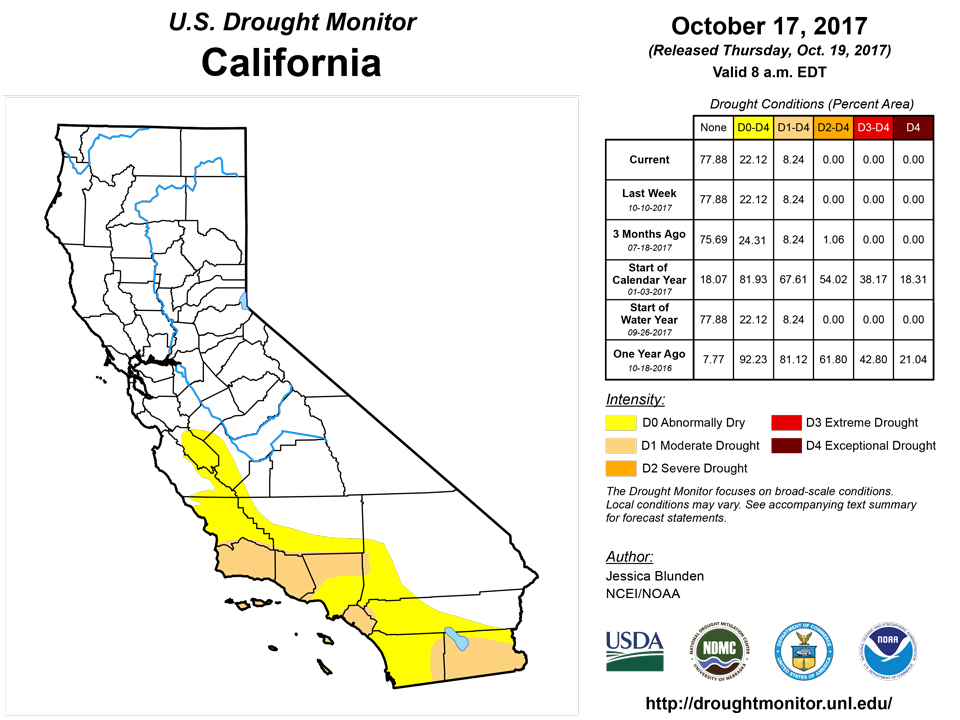
California and National Drought Summary for October 17, 2017
Summary
October 19, 2017 - As usual, there were winners and losers with respect to precipitation this week. Heavy rain fell across much of the Midwest, particularly notable in an area stretching from eastern Iowa northeastward to Michigan where upwards of 600% of typical precipitation for the week was received. Rainfall was below-average across most of the Northeast, the South, and Southeast. Additionally, temperatures were almost summer-like for several days from the Midwest to the Northeast, where departures were up to 15-30 degrees F above average in places, making it feel like August rather than October in many places. The dryness and heat brought about expansion of dry areas across parts the South, Southeast, and Northeast, while the Midwest saw the most improvements this week.Northeast
Dry conditions over the past few months led to the introduction of moderate drought (D1) from much of central and eastern Connecticut and northern Rhode Island northeastward to northern Middlesex County, Massachusetts. Recent streamflows are low in these areas. Farther north, abnormally dry (D0) conditions were expanded in southwestern Maine and over most of New Hampshire, with the exception of the Merrimack and Hillsborough County areas in the south. Continuing dryness led to the expansion of moderate drought (D1) around Kennebec County south into northern York County. In Cumberland County, Gray, Maine is currently 9.15 inches below normal since June 1, while Portland is 6.74 inches below normal, also since June 1.Southeast
West of Charlottesville, the small area in western Virginia/extreme eastern West Virginia that indicated normal conditions was downgraded to abnormal dryness, similar to the surrounding area. Water restrictions are being implemented in Charlottesville, and while Charlotteville itself was already designated as an abnormally dry area, the entire Rivanna watershed was not. Most streamflows are low across this area. Similarly, in southwestern Virginia, Wise and southwestern Dickenson Counties also saw the introduction of abnormally dry conditions (D0) due to rainfall deficits combined with above-average temperatures.Abnormally dry conditions expanded southeastward from South Carolina into eastern Georgia to Morgan, Putnam, Baldwin, north Wilkinson, Washington, Jefferson, and Burke Counties. To the southwest, another area of abnormal dryness was introduced from Macon County to Colquitt County and close to the Florida and southeastern Alabama borders.
Abnormally dry conditions were also expanded in western Alabama, to encompass Fayette County south to northern Clark County, indicating dryness over the past couple of months.
South
Adjoining the southwestern Virginia counties noted in the Southeast section, abnormal dryness (D0) was extended into part of northeastern Tennessee, namely Claiborne, Hancock, Hawkins, and Sullivan Counties, due to recent dryness. In extreme northwestern Tennessee, abnormal dryness was extended southeastward to include Lake and Obion Counties.Abnormal dryness in Mississippi was expanded west and northwestward into Yazoo, Humphreys, Leflore, Holmes, Carroll, and southern Montgomery Counties. Pastures in this area are very dry and producers have been feeding hay for the past two weeks.
Dryness was also notable across most of Arkansas, where a swath of abnormal dryness was extended from Greene County in the northeast south to Ashley County. Additionally, moderate drought (D1) conditions were expanded across most of the western half of the state. In neighboring Louisiana, abnormal dryness stretched across the northern region of the state near the I-20 corridor.
Southern and eastern Texas saw some expansion of abnormal dryness and a bit of moderate drought. Interestingly, some areas have reversed from flooding (Hurricane Harvey) to dryness, with less than an inch of rain recorded over the past 45 days.
Conversely, in Kansas, moderate drought conditions improved in Marshall and Nemaha Counties, while the surrounding area, and east to Brown and Doniphan Counties, returned to normal thanks to recent heavy rainfall. Conditions also improved to normal across a large swath from southeastern Kansas to northeastern Oklahoma, where up to 2 inches of rain fell over the past week.
Midwest
Conversely, in Kansas, moderate drought conditions improved in Marshall and Nemaha Counties, while the surrounding area, and east to Brown and Doniphan Counties, returned to normal thanks to recent heavy rainfall. Conditions also improved to normal across a large swath from southeastern Kansas to northeastern Oklahoma, where up to 2 inches of rain fell over the past week.Ohio saw slight improvements in the central portion of the state, where abnormal dryness (D0) contracted slightly northward around Fairfield, Perry, and Morgan Counties. However, in the northwest around Sandusky, Seneca, Wyandot, and Hardin Counties, abnormal dryness expanded a bit. Missouri also saw a northwestward expansion of abnormal dryness. Additionally, moderate drought reached into Shannon, Oregon, Howell, and Ozark counties in the east and Stone, Barry, Christian, southeast Greene, and southern Webster along the west boundary. Over the past 30-60 days, much of southwest, south central and central Missouri has recorded rainfall totals 2-4 inches below normal.
High Plains
Dry conditions improved in southeastern Nebraska and northeastern Kansas (see Midwest section).Abnormally dry conditions were expanded to the San Juan Mountains and Four Corners in southwest Colorado. This area did not receive as much moisture as areas to the north, west, and east during a recent wet spell.
Much of the Dakotas continued to see improvements, with recent rainfall helping to slowly alleviate ongoing drought conditions. While there are lingering long-term deficits, local experts in North Dakota observe that farming conditions are currently very good.
West
Montana is experiencing slowly improving conditions, including vegetation and soil moisture. However, in Valley, Roosevelt, and McCone Counties, empty stock ponds remain and there are still large cracks in the soil. This week, conditions improved enough such that exceptional drought (D4, the most dire category) in the north near this area was improved one category to extreme drought (D3). Overall in Montana, large deficits still remain across the state. For example, Glasgow is 5 inches below normal for the year-to-date (53% of normal) and Zortman is 4.75 inches below normal (69% of normal). Wildfires still continue to burn in areas.In Oregon, conditions have improved and moderate drought (D1) in Oregon and southern Washington were upgraded to abnormally dry (D0), which better reflect current impacts in the region.
Alaska, Hawaii, and Puerto Rico
No changes were made to any of these regions this week.Looking Ahead
For the week of October 17-23, the extreme Northwest and the South/Southeast are likely to receive above-average precipitation, very heavy in the Northwest and up to 3 inches in parts of the South. Less than half an inch of precipitation is forecast across the mid-Atlantic states, the Northeast, and the High Plains into Montana. Looking a bit further to the October 22-26 timeframe, above-normal temperatures are expected over the western U.S, while parts of Texas may see below-average temperatures. Below-normal precipitation is also forecast for the western U.S. Looking even further out to the week of Oct 24-30, most of the contiguous U.S. is favored to see below-average precipitation, while above-normal precipitation is favored across the Appalachians and eastward. The Great Lakes region is also favored to receive above-normal precipitation at this time.Author(s):
Jessica Blunden, NOAA/NCEI
Dryness Categories
D0 Abnormally Dry—used for areas showing dryness but not yet in drought, or for areas recovering from drought.Drought Intensity Categories
D1 Moderate DroughtD2 Severe Drought
D3 Extreme Drought
D4 Exceptional Drought
Drought or Dryness Types
S Short-Term, typically less than 6 months (e.g. agricultural, grasslands)L Long-Term, typically greater than 6 months (e.g. hydrologic, ecologic)
Source: National Drought Mitigation Center









